- You are here:
- Home »
- Carroll
Tag Archives for " Carroll "
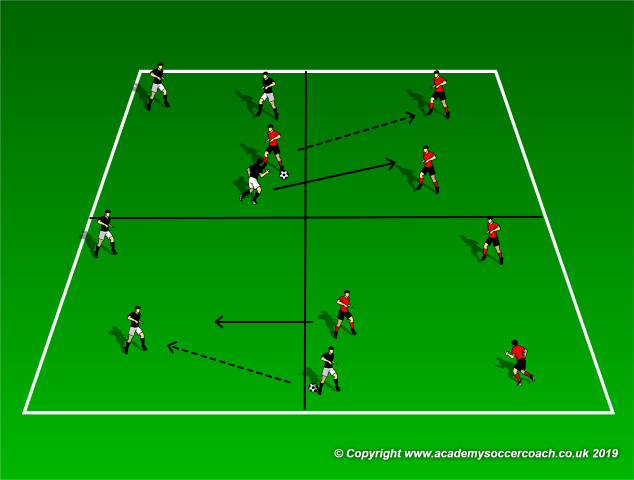
3v1 Possession Drill
By Keith Scarlett –
Line a field into 4 15 yard boxes per the diagram.
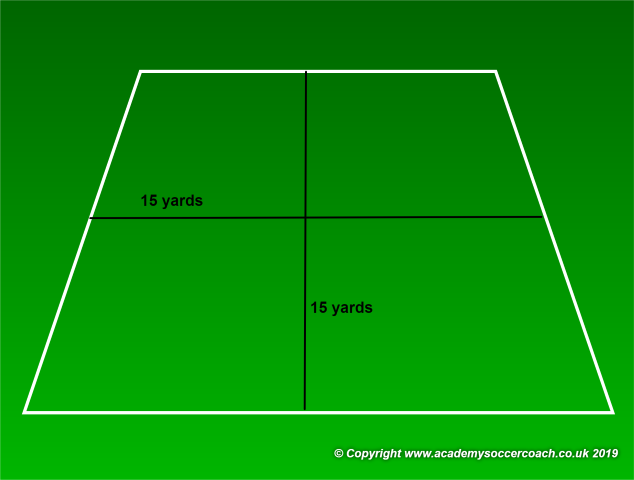
Players are positioned in the grids as the diagram shows.
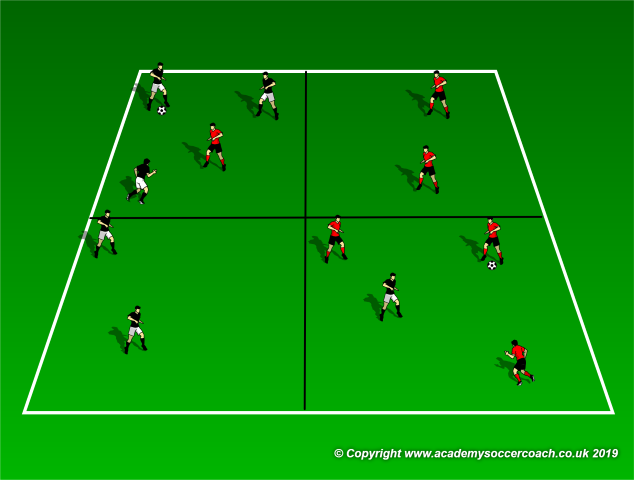
They play 3v1 for possession in their grid.
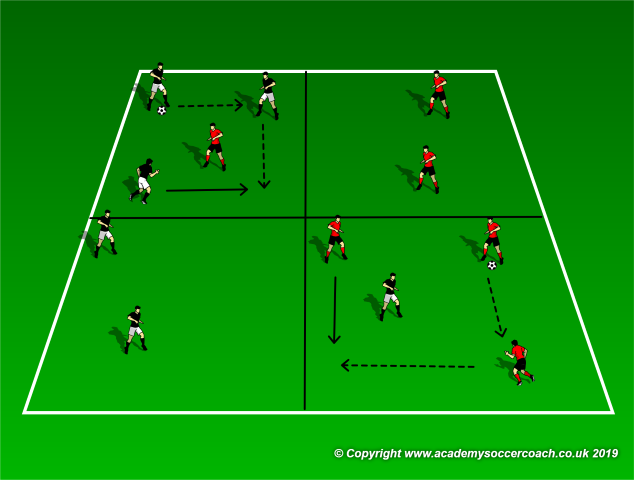
When the defender wins the ball, they immediately transition to the other grid and play in their two teammates. The player who lost the ball trails and plays defense in the new grid.

By Keith Scarlett

Competitive 1v1s to Goal
By Keith Scarlett –
Setup at the halfway line as in diagram below.
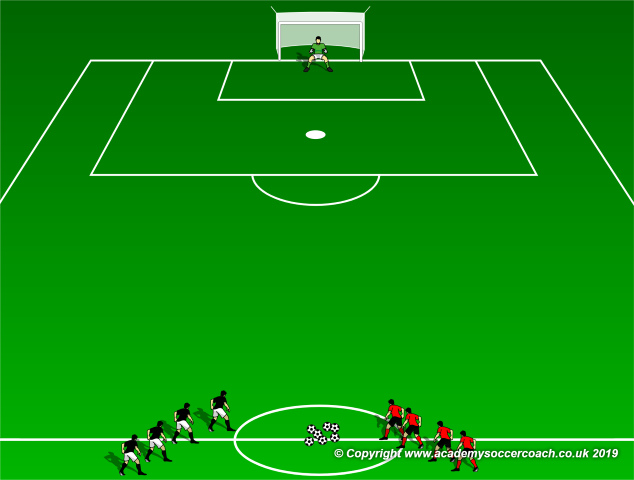
Once ball is played forward and the first person in each line takes off after it.
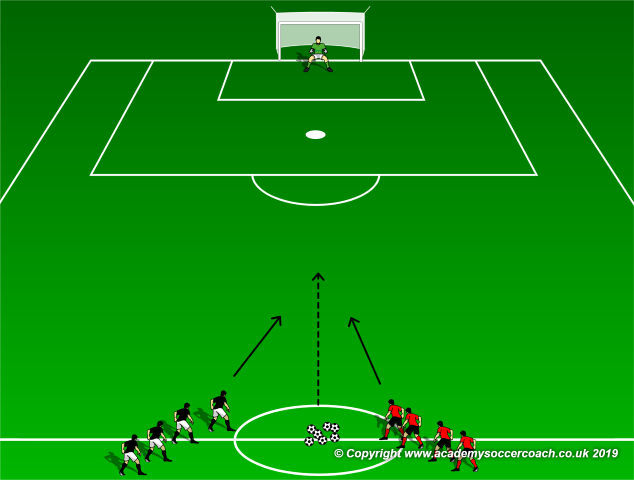
The player who gets to the ball first has to stop for one second, and then goes 1v1 against the defender as quickly as possible.
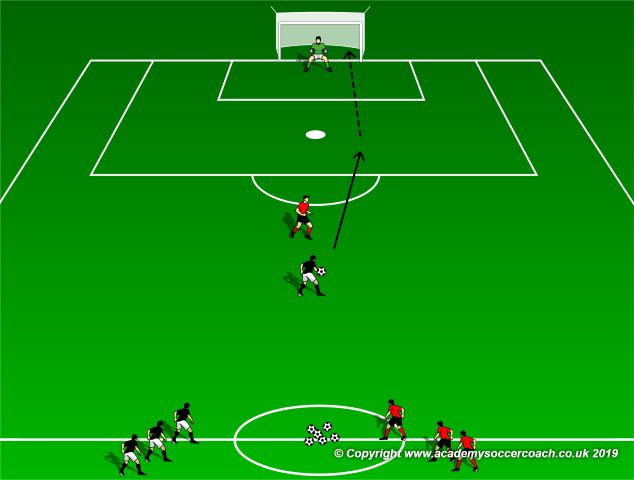
By Keith Scarlett
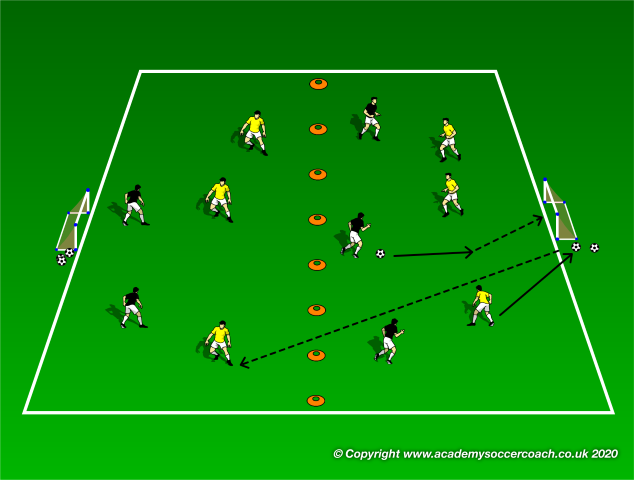
3v2 vs 3v2
By Matthew Carroll –
Description ; The 3v2 vs 3v2 drill can be used to either focus on the attacking players or the defending players. With the focus on the attacking players the teaching points can be moving with pace to take advantage of numerical superiority, scoring off numerical mismatches, or counter pressing. If the focus is on the defending side the focus can be on transition moments, staying compact, and building out the back.
Setup: Create a field appropriate for two 3v3 games back to back to each other with a small goal on either end and the field divided in half. Set up two teams of 5 and place three attacking players on one end of the grid and two of the team as defensive players on the other end. Place extra balls in or around each net for transitions.
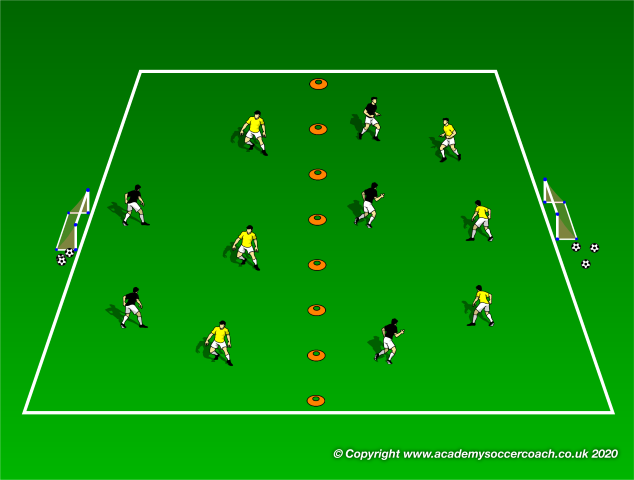
Execution: Play starts with one of the attacking teams of three starting against the oppositions team of two defenders. The attacking team attempts to score, if they do the defenders retrieve a ball from the net and must pass it to their attacking players on the other side.

If the defending team intercepts the pass or the shot misses the goal the defenders still attempt to pass to their attacking players, but now the opposition attacking team can attempt to defend them and win the ball back to try and score. Play continues until a designated time elapses or a score is reached.
Variations: The number of players can be varied depending on the skill/availability of players, as long as the advantage is kept by the attacking side. Goals size can be increased and goalies added as the number of players increases.
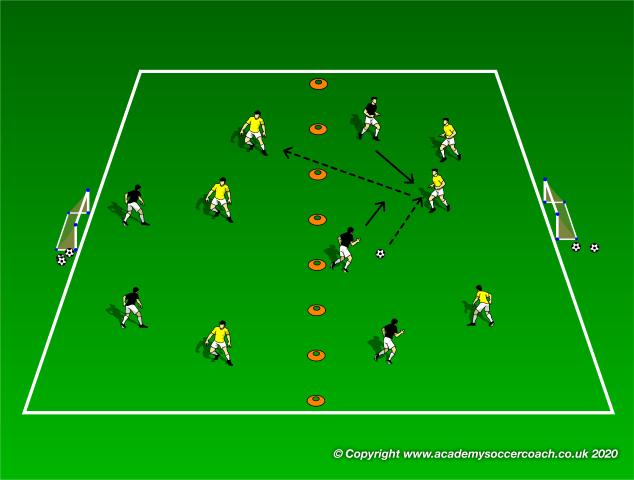
By Matthew Carroll

Possession Then Long Passes
By Matthew Carroll –
Description: The long and short game is designed to help players understand the importance of maintaining possession in order to create opportunities to play more direct or dangerous passes. The short passing option in this game requires skill but is much more forgiving if a mistake is made. The long passing option is more rewarding but requires more skill and accuracy with few chance of success, simulating a realistic game experience.
Setup: Create a grid with four cones in a rectangle. The halfway point between each side should be marked off with a cone. Between the long sides, halfway, cones or coaching sticks should be placed to create a gate. Four cones should be placed in the middle for four defenders to stand on. The rest of the players should be lined up at the four outside cones.
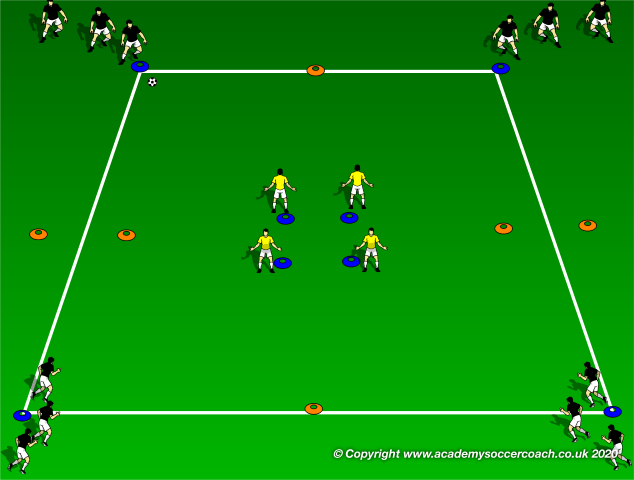
Execution: Play starts when a player at one of the cones passes to the cone to the side of them (they cannot pass to the diagonal cone) and the passer follows their pass to the end of the line at the cone that was passed to. The ball must travel halfway to its target and then the defender in the middle can go and attempt to steal the ball. If they are able to win possession the player that was intended to receive the ball must become the defender. If the pass is received the receiving player then can look to pass back where the ball came from, or the option to their left/right.
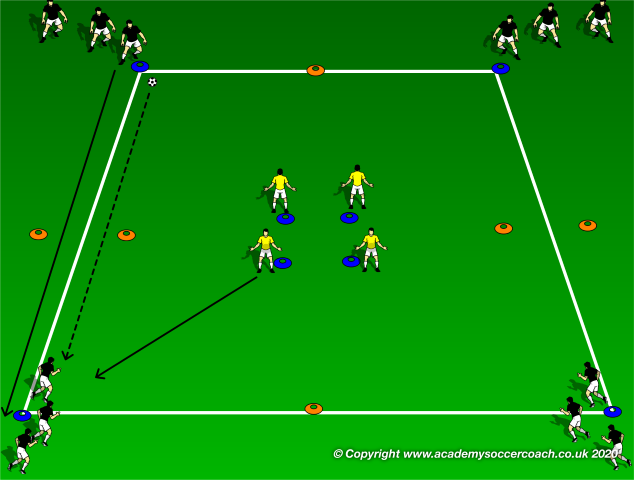
The unsuccessful defender must return to their cone at a jogging pace, but if the ball comes back to their side, as long as they were making an effort to return to their cone, they can go and defend a pass in their area without returning to their cone.
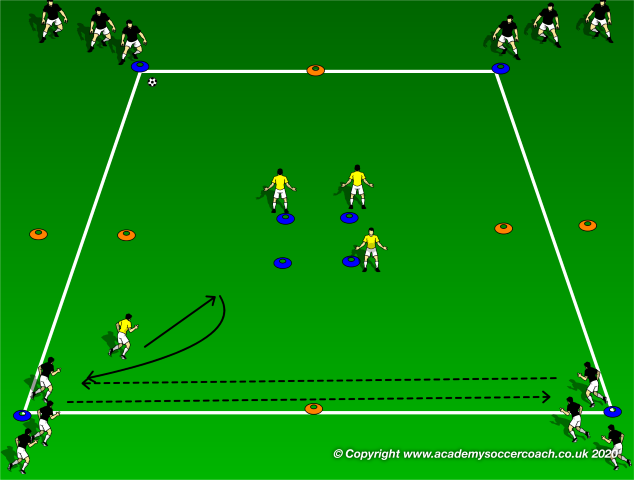
Variations: The length of the sides can be varied by age, ability, and intended result. The number of touches by the receiving player can also be modified to increase/decrease the difficulty involved.
By Matthew Carroll
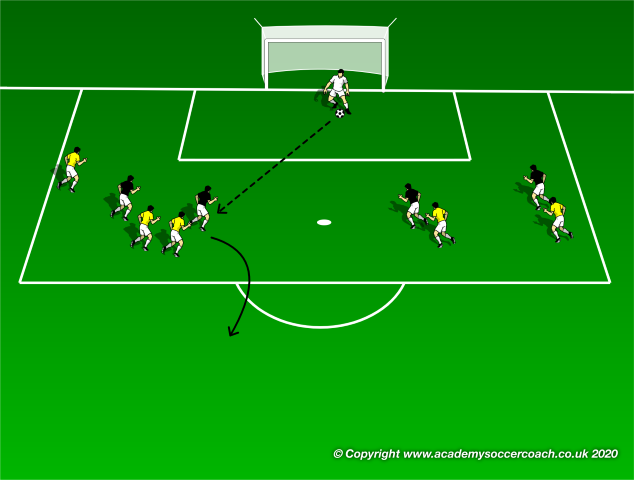
Box Breakout Game For Defending
By Matthew Carroll –
Description: This drill can be used to train defenders to be able to play under pressure near their own goal with confidence and to utilize the keeper in the build up. It forces players to take on 1v1 duels with the added pressure that if they lose the ball or do not immediately pressure and win the ball back they will let up a goal.
Setup: Place 4 field players and a goalie into the 18, Place 5-7 defenders outside the 18. Play should start from the goalkeeper who should have a stock of balls.
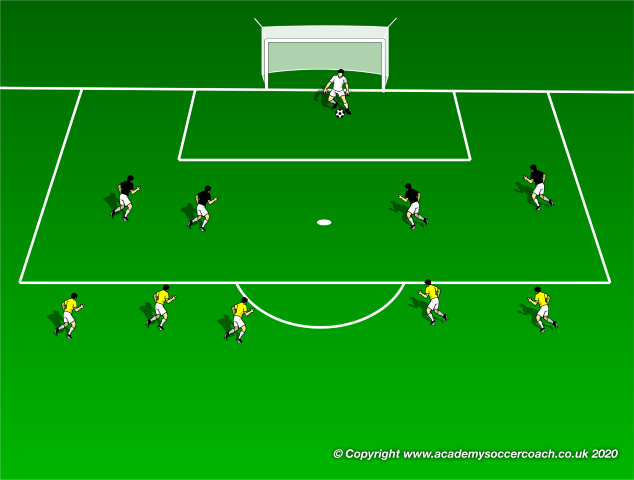
Execution: Play starts when the goalie rolls the ball out to one of the players in the 18.The defenders cannot enter the box until one of the players in the 18 first touches the ball. Once play starts the defenders attempt to win the ball and score on the goal.
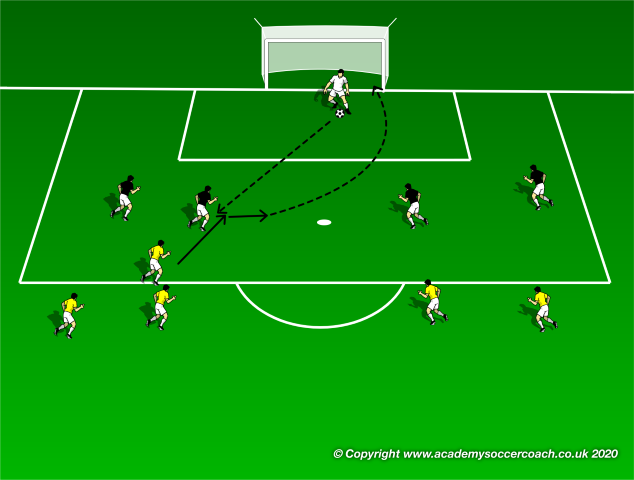
The players in the box win the game by dribbling out of the 18 with control. Play then resets with the defenders leaving the box and the goalie restarting the ball.

Variations: Breakout goals can be added as targets for the players in the box to score on. To increase intensity, after a game ends, a new set of attackers and defenders can be added to give breaks to each group.
By Matthew Carroll
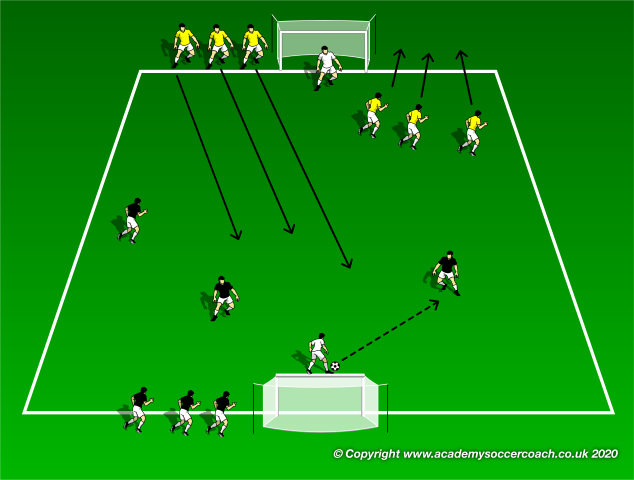
Transitions with Overlaps
By Matthew Carroll –
Description: This is a twist on the classic transition game that helps players recognize opportunities to overlap within a game. Coaches should allow the game to start off naturally, and then stop midway through to ask players to identify when overlapping was effective, and when it was ineffective because they were forcing overlaps for the sake of the drill. Players will naturally realize long overlaps are good for wide spaces to exploit the compactness of the opposing defense, and short, quick overlaps are better for the midfield or creating a shooting opportunity.
Setup: Set up two goals about 40 feet apart. Width can be as wide as the touch lines or cones can be added to restrict the width. A minimum of four teams are created with a goalie in each net. Place a large amount of balls in each net. A team should be placed at each post and teams on the same post should be wearing the same color, or every individual team can be wearing a different color.
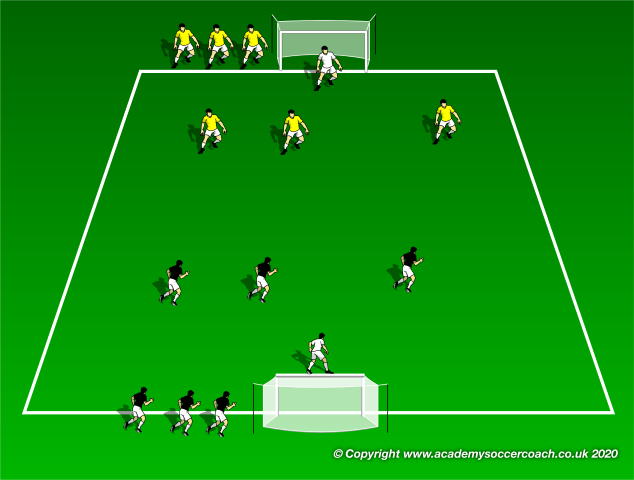
Execution: The game starts with one team from either goal in the field of play, attempting to score on net. Teams cannot score unless an overlap occurs at some point in the game, the coach can even become more specific requiring a certain type of overlap, or one that occurs on a certain part of the field. The game ends when a team scores, or a team shoots and misses.
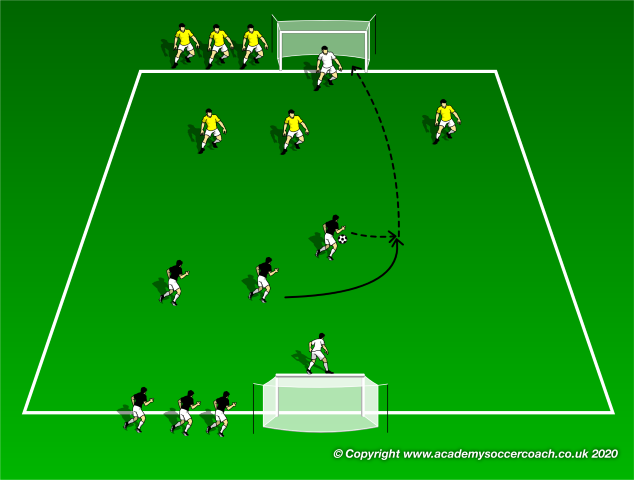
If a team scores they run back to their net and get a ball out of the goal to restart play, and must find a new overlap before scoring. The team that got scored on leaves the field and the team standing by the post then comes on and also must find an overlap before scoring. If a team misses a shot, the team that misses the shot leaves the field and the defending team stays on with the same requirements.

Variations: Specific overlaps can be required, or that they occur on a certain part of the field. Number of players per team/numbers of teams can vary. Size of the field can also be varied. A rule can be added that a team that has not completed their overlap can score if they intercept the opposition’s overlap and score from that possession.
By Matthew Carroll
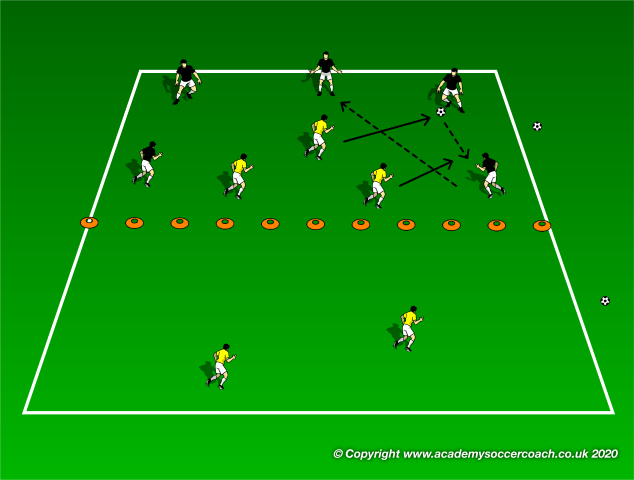
5v5 Transition Game
By Matthew Carroll –
Description: This is a great drill for teaching transition moments both offensively and defensively. There are opportunities to discuss counter pressing, transitional passing patterns, width, depth, and can even be used as a game day warm up to start players focusing on the flow of the upcoming game.
Setup: Create a 40×20 grid then split that evenly to create two 20×20 grids. Place five players from one team in one grid, with three opposition players with them. In the empty grid place the two remaining players. Have some balls near each grid to create a clear transition when the ball goes out.
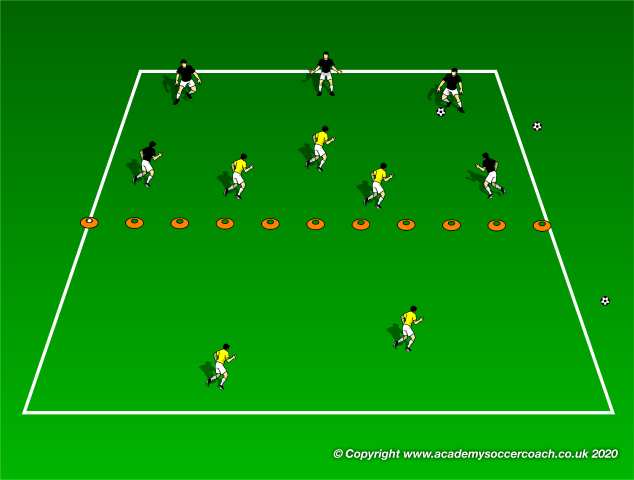
Execution: The game starts when the coach plays the ball to the five person team, the three person team attempts to press and win the ball back.

If the defending team wins the ball their objective is to move the ball to the other two players in the other grid. Once they do so they want to quickly create width and have all players in a large rondo. The team that has lost the ball initially wants to press the ball so it cannot go into the other grid. If it does though, the team that lost the ball then must send three players over to try to win the ball back, leaving two players behind for when they win and transition back.
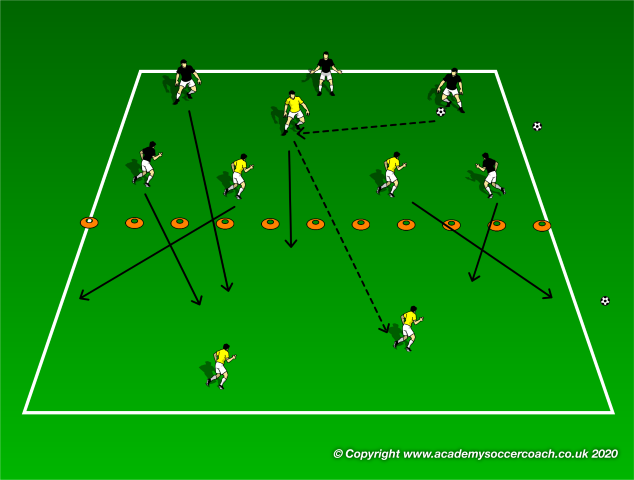
Variations:
The number of players that are in each grid/are allowed to defend can be modified
Winning conditions can be added such as fastest transitions, most time spent on the ball, most transitions, etc.
By Matthew Carroll
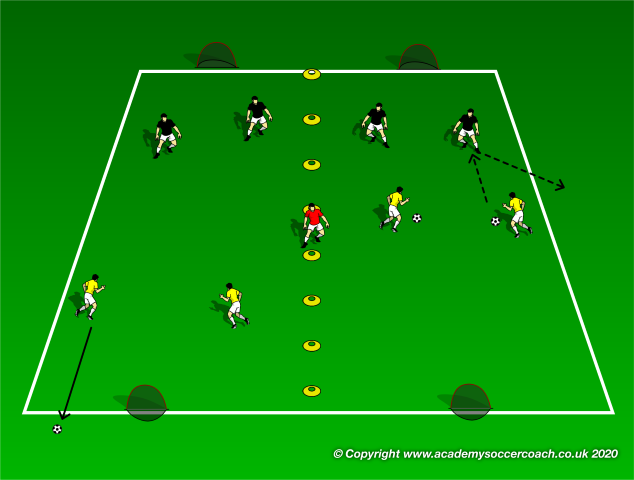
Side by Side Transition Game
By Matthew Carroll –
Description: This small sided game is used to improve game and spatial awareness with a focus on utilizing the 6 to switch play. It can also be used to teach defensive positioning and 1v1s
Setup: Create two grids that are connected in the middle. The size of the grid should be determined by the number of players and their skill level. Create two teams to play each other, then split those teams in two so team 1A will face team 2A and 1B will face 2B. Place one or two neutral players on the line that divides the grids. Place small sided goals at either end of each grid.
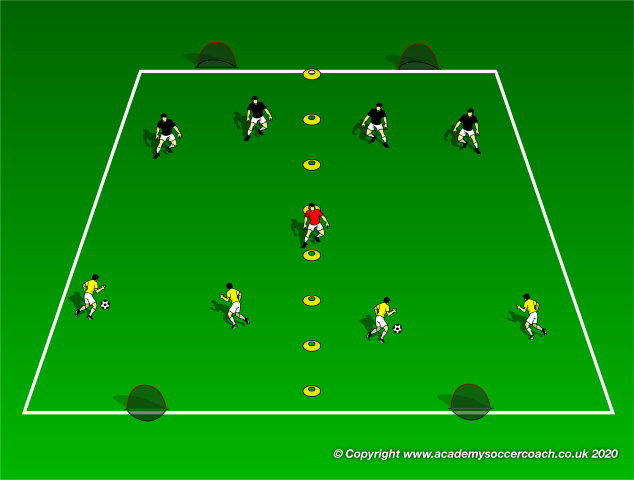
Execution: Play starts with a ball in each grid. Both teams play a small sided game against each other in their own grids. The neutral player, representing the 6, can receive the ball and either play it back into the grid where the ball came from or transition the ball to the opposite grid to the same team he received from the other grid.
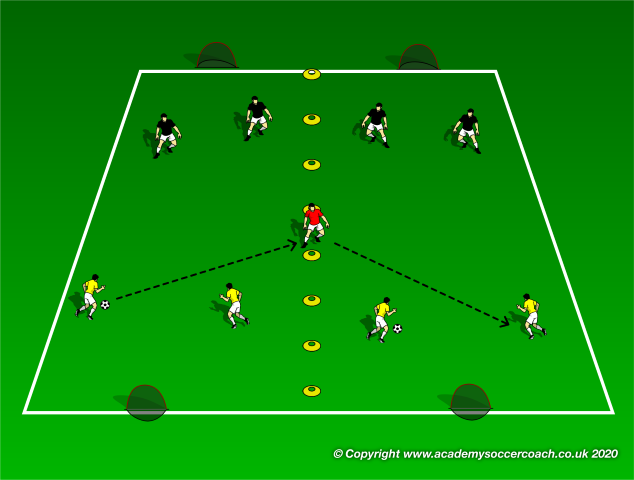
Once this happens the grid with two balls plays the game with both until a ball goes out, once one ball goes out the ball starts on the opposite grid with the team who should have possession on the other grid.

Winner is the team that has the most combined goals between the two grids.
Variations:
Depending on the system of the team, additional 6s can be added to more realistically depict the system
An additional stipulation can be added that as soon as the ball enters the opposite grid, that grid plays with the two balls, and the grid with none picks up another ball, this can continue as long as the balls stay in bounds, once they go out they stay out unless the grid has 0 balls in play.
By Matthew Carroll
